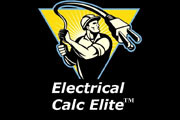A Circuit Breaker
A circuit breaker offers protection and safety of your high voltage residential wiring and is installed in your breaker box. These devices include single pole breakers, double-pole breakers, GFCI breakers, ARC fault breakers, surge protectors and fuses. The following webpage will explain the proper application for each type of circuit breaker. Keep in mind you should always reference electrical codes in your area to ensure you are meeting requirements.
Single Pole Breakers
A single-pole circuit breaker is one of the most common types of breakers found in homes. They protect a single 120V circuit and are typically rated at 15A or 20A. A 15A breaker is used to protect a 14gauge romex circuit for lighting or outlets. A 20A circuit breaker is typically used to protect a 12gauge romex circuit. A single-pole circuit breaker takes up a single slot in a breaker panel and has one screw to connect your line wire (usually black). These circuit breakers cost about $3-$4 each at Home Depot. The picture below shows what a single-pole circuit breaker looks like.
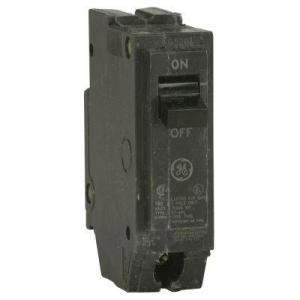
Double Pole Breakers
The next most common type of breaker in a home is a double-pole circuit breaker. Double-pole breakers protect the 240V circuits in your house such as a range, air conditioner, water heater, or electric dryer. Unlike a single-pole circuit breaker that often feeds a branch circuit with multiple outlets or light fixtures attached, double-pole breakers are usually point-to-point for the appliance they are protecting. As such, you should see these circuit breakers labeled in your break panel for the device they are protecting (i.e.. Range or Air Conditioner). These breakers typically start at 30A but can go as high as 100A or more. Selecting the proper amperage on a circuit breaker is key to protecting the down-stream wiring and for preventing fires in your home. You should never, under any circumstances, replace a breaker in your panel with a higher amperage breaker. For example, if you have a circuit that is sized for 30A for a standard water heater and later decide to upgrade to an on-demand water heater that needs a 60A circuit. You cannot just change out the breaker to a 60A or you will overload your wiring and likely cause a fire!
Double-pole circuit breakers have two screws for attaching line wires. You will usually attach the red and black wires from your 240V appliance to these terminals. Double-pole breakers cost about $8-9 for a 30A to around $35 for a 100A at Home Depot. Below is a picture of a double-pole circuit breaker. These take up two slots in a breaker panel.
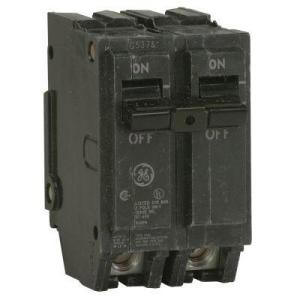
HACR Rated Circuit Breaker
HACR stands for Heating, Air-Conditioning, and Refrigeration breaker. HACR rated breakers open within a specified time curve, similar to a fuse, to protect group motor equipment (fans for combustion air, exhaust control, heated air handling, AC compressors, etc). Years ago, breaker manufacturers were not consistent on this tripping time, hence HVAC equipment was typically certified by UL using fuses. This eventually led to the HACR breaker which has the same time/trip curve regardless of who makes it. For an acceptable installation, the end-use equipment must be marked to indicate that “HACR Type” circuit breakers may be used for branch circuit overcurrent protection. The 2005 NEC permits the use of any inverse-time type circuit breaker in heating, air-conditioning and refrigeration equipment comprising group motor installations. Back in the mid 80's UL changed their testing procedure with the end result that today all "new" multi-pole breakers are automatically HACR rated. This makes life easy, you can pick up a standard two-pole breaker for $8-9 bucks and have what you need to protect your HVAC equipment.
GFCI Circuit Breaker
Some homes may have Ground Fault Circuit Interrupter (GFCI) circuit breakers to eliminate the need for GFCI receptacles to be installed in wet locations such as kitchens, bathrooms, or garages. A GFCI circuit breaker is designed to trip immediately if there is an imbalance of electric flow. In other words, current in a normal circuit is designed to be fed by the hot wire and return current comes back through the neutral wire. A GFCI monitors this and if more current is going out on the hot wire than what comes back on the neutral, the breaker trips. This would indicate an unsafe condition where current is taking another path to ground, like through a person or appliance that is plugged in. GFCI circuit breakers feature a "test" button on the front that you can use to test that it's working properly. This is the same sort of feature you find on GFCI receptacles. After you press the "test" button you will have to reset the breaker to turn the circuit back on. The curly white wire pre-attached to a GFCI break must be tied into your breaker panel neutral bar. A GFCI circuit breaker will have two terminals. One for the line and one for the neutral feeding your circuit. Single Pole GFCI circuit breakers cost about $40 each. Below is a picture of a GFCI circuit breaker.

Double Pole GFCI Circuit Breaker
Double-pole GFCI circuit breakers protect 240V circuits around potentially wet areas such as swimming pools, hot tubs and outside a house. These breakers work similar to a single-pole version however they detect an imbalance on the two hot lines in the 240V circuit. In a 240V circuit the current is fed on one hot wire and returned on the other (instead of the neutral). If the breaker detects current being returned somewhere else, like a human body or wet appliance leaking current to ground, it trips. A double-pole GFCI breaker will have a neutral input for connecting appliances such as a hot tub or spa. This is because a hot tub will have some things running off of 120V and others, like the pumps, running on 240V. If a neutral is present on the appliance, use the neutral input on the breaker. If a neutral wire is not present, for instance you are connecting a small 240V irrigation pump in your backyard, then it's OK not to have a neutral fed into the breaker (you still need a safety ground connection to the appliance). The breaker will still detect the imbalance with just the two line wires attached. The curly white wire pre-attached to the breaker must still be tied to the neutral bar of the breaker box, even if you aren't feeding a neutral wire to your appliance. This is required for the "test" feature on the breaker but not during normal operation. A double-pole GFCI circuit breaker is typically quite expensive at over $100 each. The picture below shows a typical double-pole GFCI breaker.
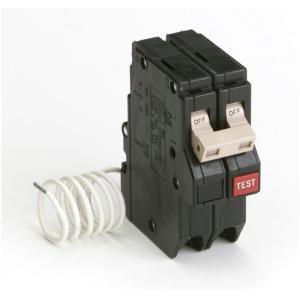
Arc Fault (AFCI) Circuit Breaker
An Arc Fault Circuit Interrupter (AFCI) is a circuit breaker designed to prevent fires by detecting a non-working electrical arc and disconnecting power before the arc start a fire. AFCIs are designed to distinguish between a working arc (i.e. brushes in a vacuum cleaner) from a non-working arc (i.e. lamp cord with broken conductor that is arcing). Conventional circuit breakers only respond to overloads and short circuits but they would not trip due to an arcing wire. Arc Fault breakers are combination breakers that protect from arc-faults and overcurrent.
The 1999 National Electric Code (NEC) requires AFCIs in all circuits that feed receptacles and outlets in bedrooms of dwelling units.
The 2002 NEC removed the word "receptacle" leaving "outlets", in effect adding lights within dwelling bedrooms to the requirement. There was still some debate on what this included
The 2005 NEC clarified outlets to include receptacles, light fixtures, and smoke alarms.
The 2008 NEC requires installation of combination-type AFCIs in all 15 and 20 amp residential circuits with the exception of laundries, kitchens, bathrooms, garages and unfinished basements.
The bottom line is AFCIs are highly advanced and much safer circuit breakers for your house. The electric codes have moved towards these devices because of that and most new construction now will require them. AFCI breakers cost similar to a GFCI breakers at around $35-40 each. Below is a picture of an ACFI breaker.
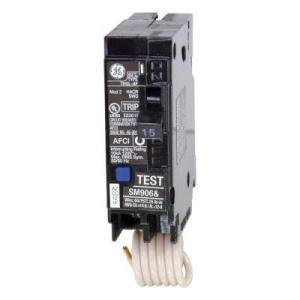
Whole-House Surge Protectors
Surge protectors are relatively new in the residential electrical panel arena. This piece of equipment provides surge protection to your entire home rather than just select equipment like a surge strip for your TV. These surge protectors install like a circuit breaker in your panel (require two single slots). You can also get ones that install in-line before your breaker panel. These will protect sensitive electronic equipment such as computers, televisions, stereos, VCRs and other appliances with around 30,000 amps of surge protection. This is much better protection than you will get out of a surge strip. To protect devices in your house, excess or surge energy must be shunted to ground before it hits the victim device. Putting the protection at the breaker panel, where you have your best path to ground, is much more effective, and knocks the surge down before it has a chance to propagate through all circuits in your entire house. There is no reason to throw away your surge strips if you get a whole-house surge protector as they merely add a second layer of protection and will not hurt anything. Whole-house surge protectors cost around $80 to $110 depending on brand. Below is a picture of a whole-house surge protector called SurgePro made by GE.

Residential Fuses
Fuse panels can still be found in older homes (early 1900s) but they are not used anymore. People are typically looking to upgrade fuse panels to a more modern circuit breaker panel when they redo their wiring. Fuse panels were often used in conjunction with the old knob-and-tube wiring. Below are some pictures of knob-and-tube wiring as well as some fuse panels.
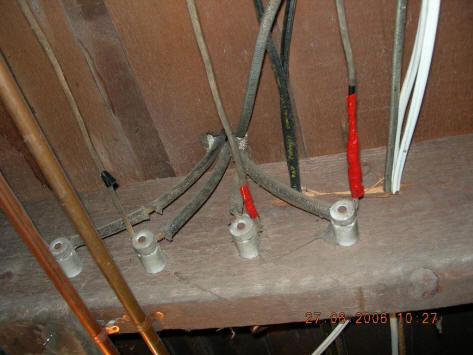

Calculator for Sizing a Circuit Breaker
| *Standard sizes for circuit breakers and fuses are defined by NEC 240-6(a). With a given circuit amperage (less than 800A), you are allowed to size up or size down to the closest standard size circuit breaker. You must size down for circuits greater than 800A. You must also size down for conductors that are part of a multioutlet branch-circuit supplying receptacles for cord and plug connected portable loads. |
Residential Electrical Guidelines and Codes
Rough-In Electrical and Pulling Cable
Common Electrical Wiring Diagrams
Wire Gauge and Voltage Drop Calculator
NEC Reference Tables (2011, 2008, 2005, 2002, and 1999)
Sizing Your Electrical Service
Electrical - Main Service Line Installation
Click the icons below to get our NEC® compliant Electrical Calc Elite or Electric Toolkit for Android and iOS. The Electrical Calc Elite is designed to solve many of your common code-based electrical calculations like wire sizes, voltage drop, conduit sizing, etc. The Electric Toolkit provides some basic electrical calculations, wiring diagrams (similar to those found on this website), and other electrical reference data.


